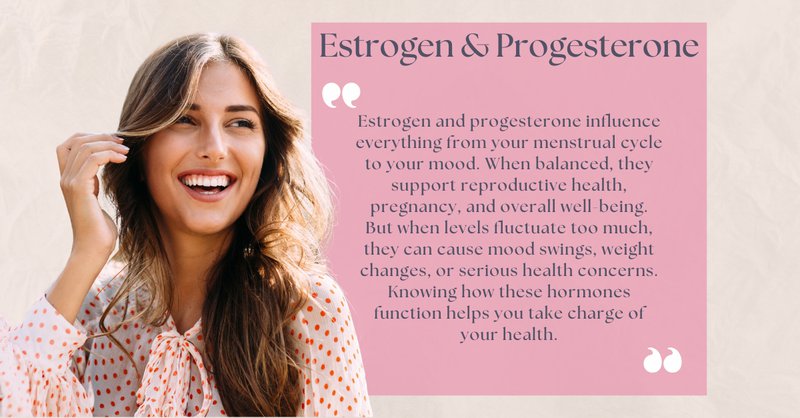Estrogen and progesterone influence everything from your menstrual cycle to your mood. When balanced, they support reproductive health, pregnancy, and overall well-being. But when levels fluctuate too much, they can cause mood swings, weight changes, or serious health concerns. Knowing how these hormones function helps you take charge of your health.
Key Takeaways:
- Estrogen and Progesterone Functions: These hormones regulate puberty, menstruation, pregnancy, bone health, mood, and brain function.
- Estrogen’s Role: Produced in the ovaries, fat tissue, and adrenal glands; helps develop female traits, regulates menstrual cycles, strengthens bones, and supports brain function.
- Progesterone’s Role: Peaks after ovulation, prepares the uterus for pregnancy, supports milk production, and also regulates the immune system.
- Menstrual Cycle Regulation: Estrogen triggers ovulation; progesterone stabilizes the uterine lining; imbalances can lead to irregular periods.
- Effects of Imbalances: Low estrogen can weaken bones and cause mood swings; high estrogen may lead to weight gain and heavy periods. Low progesterone may cause irregular cycles and anxiety.
- Impact on Pregnancy: Estrogen aids fetal development, while progesterone prevents early contractions and miscarriage.
- Hormone Replacement Therapy (HRT): Treats menopause symptoms; combined estrogen-progesterone therapy protects against uterine cancer.
- Natural Regulation: Diet (flaxseeds, salmon, spinach), stress management, and sleep improve balance.
- Mental Health Effects: Estrogen stabilizes mood; low progesterone can contribute to anxiety and sleep problems.
- Synthetic vs. Bioidentical Hormones: Synthetic hormones may have side effects; bioidentical hormones mimic natural hormones but require further study. Always consult a doctor.

Estrogen and Progesterone: Why They Matter
Estrogen and progesterone are key female hormones that control puberty, periods, and pregnancy. They also influence bone health, mood, and brain function. A balanced level of these hormones helps the body function properly.
How Estrogen Functions in the Body
Estrogen is produced in the ovaries, fat tissue, and adrenal glands. It plays a role in breast development, body shape, and soft skin. It also regulates the menstrual cycle and prepares the body for pregnancy. Estrogen also helps keep bones strong and supports brain function.
People of all genders produce estrogen. In men, it helps regulate sperm production and sex drive. An imbalance can lead to health problems.
The Role of Progesterone
Progesterone becomes most active after ovulation. Specifically, it prepares the uterus for pregnancy and supports pregnancy if conception occurs. However, if pregnancy doesn’t happen, progesterone levels drop, thereby triggering menstruation.
Progesterone has other uses, including maintaining nervous system health, regulating weight, and supporting the immune system. Men and intersex individuals also produce small amounts, which help balance estrogen.
Why Hormone Balance Matters
An imbalance of estrogen or progesterone can lead to issues such as irregular periods, mood swings, weight gain, and sleep disturbances. Hormonal imbalances may also contribute to conditions like polycystic ovary syndrome (PCOS) or osteoporosis.
Balancing these hormones helps improve overall well-being. Lifestyle changes, medical treatments, and dietary adjustments can help maintain healthy levels. Regular health checkups can also detect imbalances early.
The Influence of Estrogen and Progesterone On the Menstrual Cycle
These hormones control key phases of the menstrual cycle, which has four stages: menstrual, follicular, ovulation, and luteal. Changes in estrogen and progesterone levels drive each phase throughout these stages.
Estrogen’s Role in Ovulation
During the first half of the cycle (the follicular phase), estrogen levels rise. This helps thicken the uterine lining in preparation for a potential pregnancy. When estrogen peaks, it signals the brain to release luteinizing hormone (LH), which triggers ovulation.
Progesterone’s Role in the Luteal Phase
After ovulation, progesterone becomes dominant. Specifically, the ovaries produce this hormone from the corpus luteum, a temporary gland formed from the empty follicle. Consequently, progesterone stabilizes the uterine lining. However, if pregnancy doesn’t occur, progesterone levels drop, thereby causing menstruation.
Hormonal Fluctuations and Cycle Regularity
Cycle length and symptom severity depend on estrogen and progesterone levels. Low estrogen may delay ovulation, while low progesterone can cause irregular or heavy periods. These hormones also influence mood, energy levels, and bloating.
Balancing estrogen and progesterone supports cycle regularity. Healthy habits, stress reduction techniques, and medical interventions can help regulate these hormones.
Estrogen versus Progesterone
Although they work together, estrogen and progesterone serve distinct functions. Estrogen influences physical development, bone strength, and brain activity. Progesterone regulates the menstrual cycle and prepares the uterus for pregnancy.
Estrogen comes in three forms: estrone, estradiol, and estriol. Estradiol is the most active. The ovaries produce the majority of estrogen, but fat tissues and adrenal glands also contribute. In men, small amounts of estrogen support bone health and sperm production.
Progesterone is mainly produced after ovulation by the corpus luteum. If pregnancy occurs, progesterone maintains the uterine environment. If not, its levels drop, leading to menstruation. Men also produce progesterone, which helps balance testosterone.
These hormones interact throughout the menstrual cycle. Estrogen thickens the uterine lining, while progesterone stabilizes it. If pregnancy does not occur, both hormones decline, restarting the cycle.
When estrogen levels become too high, the risk of breast or uterine cancer may increase. Excess progesterone can contribute to fatigue and mood changes, while low levels may cause irregular periods and fertility problems.
Both hormones play a role in pregnancy. Estrogen supports fetal development, and progesterone helps prevent early contractions. Hormone levels shift across life stages, influencing mood and overall well-being.
The Impact of Hormone Imbalance
When estrogen or progesterone levels stray from normal ranges, the body may respond with noticeable symptoms.
- Low Estrogen: Hot flashes, night sweats, fatigue, mood swings, vaginal dryness, difficulty concentrating, and osteoporosis risk.
- Low Progesterone: Irregular periods, PMS-like symptoms, anxiety, trouble sleeping, and difficulties with pregnancy maintenance.
- High Estrogen (Estrogen Dominance): Weight gain, bloating, heavy periods, breast tenderness, and an increased risk of fibroids or endometriosis.
- High Progesterone: Fatigue, mood disturbances, dizziness, water retention, and irregular menstrual cycles.
Factors like stress, diet, medications, and medical conditions (such as PCOS, perimenopause, or thyroid disorders) can impact hormone levels. Long-term imbalances may contribute to fertility issues, heart disease, or osteoporosis. A medical evaluation with your provider can help identify and manage hormone-related symptoms.
How Estrogen and Progesterone Influence Pregnancy
These hormones play critical roles throughout pregnancy.
- Estrogen: Supports fetal development, increases blood flow to the uterus, and aids in placenta formation.
- Progesterone: Prevents early uterine contractions, thickens cervical mucus to block infections, and reduces the risk of miscarriage.
Hormone levels shift during pregnancy. In the first trimester, progesterone rises to sustain the fertilized egg. By the second trimester, the placenta primarily produces hormones. Estrogen peaks before birth to prepare the body for labor.
Imbalances may create complications, which is why doctors closely monitor hormone levels throughout pregnancy.
Hormone Replacement Therapy (HRT)
HRT is used to relieve menopause symptoms caused by declining estrogen and progesterone levels. It reduces hot flashes, mood swings, and bone loss. The two main types are estrogen-only therapy and combined estrogen-progesterone therapy.
- Estrogen-Only Therapy: Prescribed for individuals who have had hysterectomies, as estrogen alone increases the risk of endometrial cancer.
- Combined Therapy: Includes progesterone to balance estrogen’s effects on the uterine lining.
HRT can lower osteoporosis risk and support brain function but carries risks such as blood clots, stroke, and breast cancer. A doctor can help determine the best approach.
For more details, visit hormone therapy for menopause.
Estrogen and progesterone shape reproductive health, menstrual cycles, and overall well-being. A healthy balance supports pregnancy, influences mood, and affects various body functions. Lifestyle changes, diet, and medical care can help manage symptoms and maintain optimal hormone levels. If symptoms arise, consulting a healthcare provider can provide guidance on treatment options.

Understanding Estrogen and Progesterone
Estrogen and progesterone are two key hormones that regulate the menstrual cycle, support reproductive health, and influence overall well-being. During menopause or hormonal imbalances, levels of these hormones can fluctuate, leading to symptoms like hot flashes, mood swings, and changes in bone health.
At The Woman’s Clinic in Little Rock, we offer expert guidance on hormone balance and treatment options tailored to your needs. Contact us today to learn more about how estrogen and progesterone impact your health.

